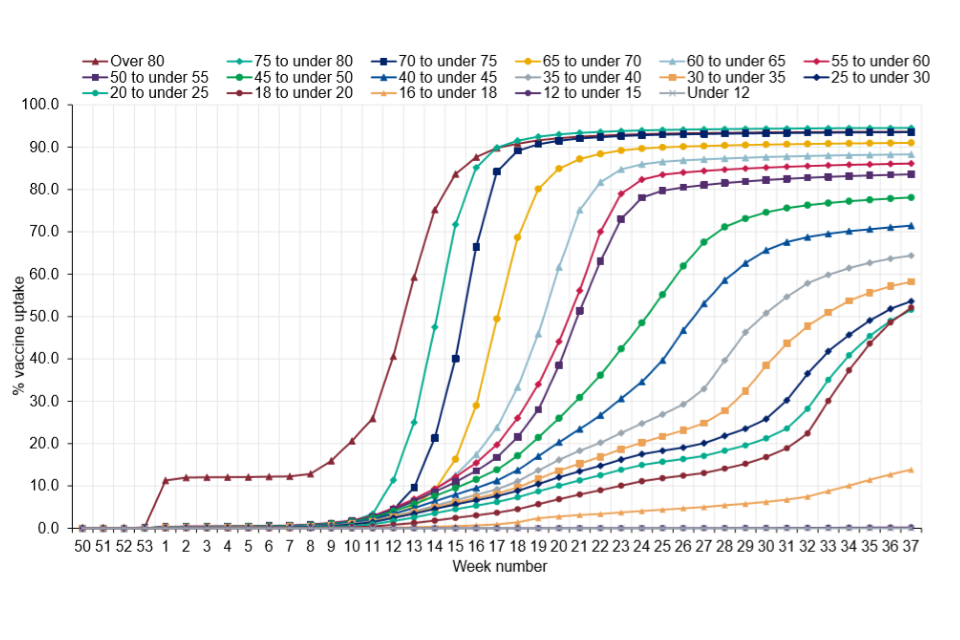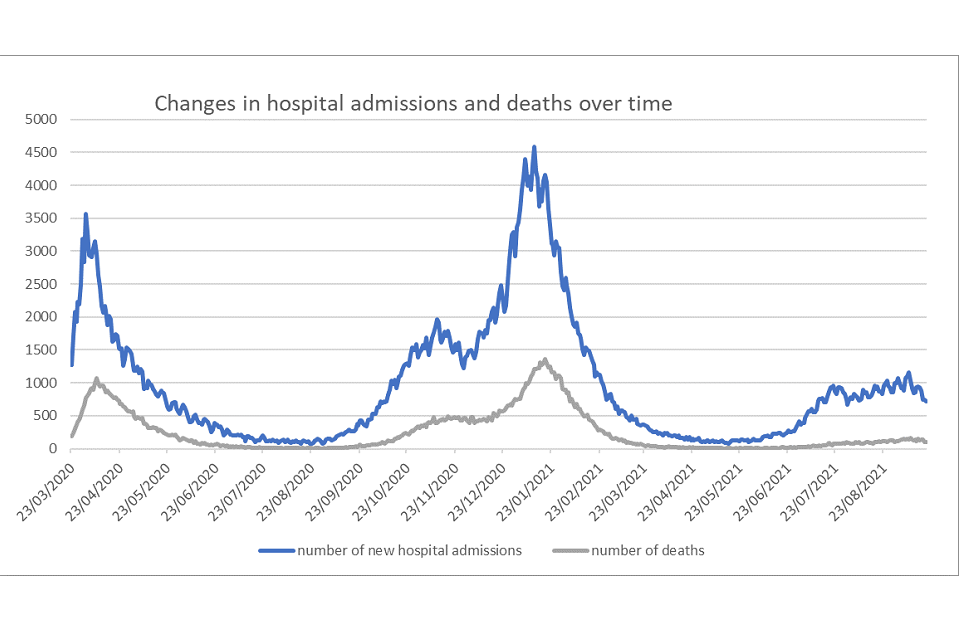Mortality Insights from GAD - September 2021
Published 30 September 2021
COVID-19 update
Welcome to Mortality Insights. In this edition we summarise the latest position on COVID-19 mortality. We also consider a recent report produced by the Office for National Statistics (ONS) considering differences in life expectancy between different ethnic groups.
COVID-19 vaccination programme
While it is still too early to predict how the COVID-19 pandemic will ultimately impact life expectancy, we are starting to see the impact of the vaccination programme. The majority of adults in England have now received 2 doses of vaccine, although this is dependent on age.
Figure 1: Percentage of people in England by age who received 2 doses of a COVID-19 vaccination by week ending 19 September 2021 (source: Public Health England).

Public Heath England (PHE) has estimated that over 120,000 deaths and around 24 million infections have been prevented in the period to 17 September 2021 because of the vaccination programme.
These figures are calculated by comparing the estimated impact of vaccination on infection and mortality against a worst-case scenario. This scenario assumes no vaccines and no non-pharmaceutical interventions were in place to reduce infections and mortality and that public behaviour remained the same.
We are also seeing a much lower number of both hospitalisations and deaths in the most recent wave than in the previous waves.
The trend is likely to be explained in part by the high number of vaccinations given to the older and most at-risk population, together with improved treatments. However, it is important to note the peak daily diagnosis in wave 2 of 68,000 was higher than the peak of just under 55,000 seen in wave 3 to date. It is hard to compare the numbers diagnosed in wave 1 due to the limited availability of testing facilities during that time.
PHE has estimated that in the period to 5 September 2021, more than 178,000 hospitalisations have been prevented in those aged 65 and over in England because of the vaccination programme. While studies suggest that the vaccinations are less effective against the more recent Delta variant than the Alpha variant, they appear to provide a similar protection against hospitalisation.
Figure 2: Chart showing the number of people admitted to hospital and deaths between January 2020 and September 2021 in the UK.

Source: UK coronavirus dashboard
Difference in mortality for different ethnic groups
Historically there has been a lack of evidence of mortality patterns by ethnic groups in the UK. However, differences in COVID-19 death rates between ethnic groups have been observed in recent research.
Following this, the ONS analysed the deaths over the 3 years following the 2011 census date of more than 50 million people - Difference in mortality for different ethnic groups. As ethnicity is not recorded on death certificates in the UK, linking death registrations to the census is the most reliable way of studying mortality by ethnicity. It shows statistically significant differences in life expectancy for different ethnic groups – see figure 3 below.
Figure 3: breakdown of different life expectancy at birth by sex and ethnic group in England and Wales 2011 to 2014.

Source: ONS
Furthermore, there are considerable differences in causes of deaths between different ethnicities. As an example, cancer mortality rates were generally significantly higher for the white ethnic group than most other groups.
The paper does not look to explain why such differences exist. It does note that smoking and drinking habits differ between ethnic groups, and differences in deprivation might be a possible mechanism to explain such a difference. Also, some groups may comprise a higher number of migrants; people who migrate generally tend to be healthier than others.
The report notes that the coronavirus (COVID-19) pandemic has had a disproportionately adverse effect on Black and Asian ethnic groups, which contrasts with the more favourable mortality pattern observed in the period 2011 to 2014.
The all-cause mortality rates of deaths in the period January 2020 to March 2021 published by the Office for National Statistics showed that, compared with the white British ethnic group:
- males and females in the Bangladeshi and Pakistani ethnic groups, and males in the black Caribbean ethnic groups had higher mortality
- both males and females in the Chinese and ‘other’ ethnic groups had lower mortality
- females in Indian, black African ethnic groups also had lower mortality
- remaining ethnic groups showed no statistically significant differences
GAD colleagues on secondment to the Department of Health and Social Care helped develop an award-winning predictive model in which ethnicity is one of the risk factors input. The COVID-19 Population Risk Assessment powered by QCovid® is used to estimate the risk of serious health outcomes due to COVID-19 for individuals.
Final thoughts
The increasing vaccination coverage across the world will continue to reduce the impact that COVID-19 has on future death rates.
There is uncertainty around the effectiveness and levels of protection of vaccines over time and the future evolution of the virus. This means the longer-term impact on future life expectancy both in different groups in the UK and globally is unclear. However, it’s becoming increasingly evident that risk factors between different groups can be significant.
It is also unclear how the pandemic will impact survivors, both directly due to cases of long-COVID and indirectly due to changes in other medical treatments. It is likely we’ll be considering the impact for several years to come.
Disclaimer
The information in this newsletter is not intended to provide specific advice. Please see our full disclaimer for details.
The Government Actuary’s Department is proud to be accredited under the Institute and Faculty of Actuaries’ Quality Assurance Scheme.
